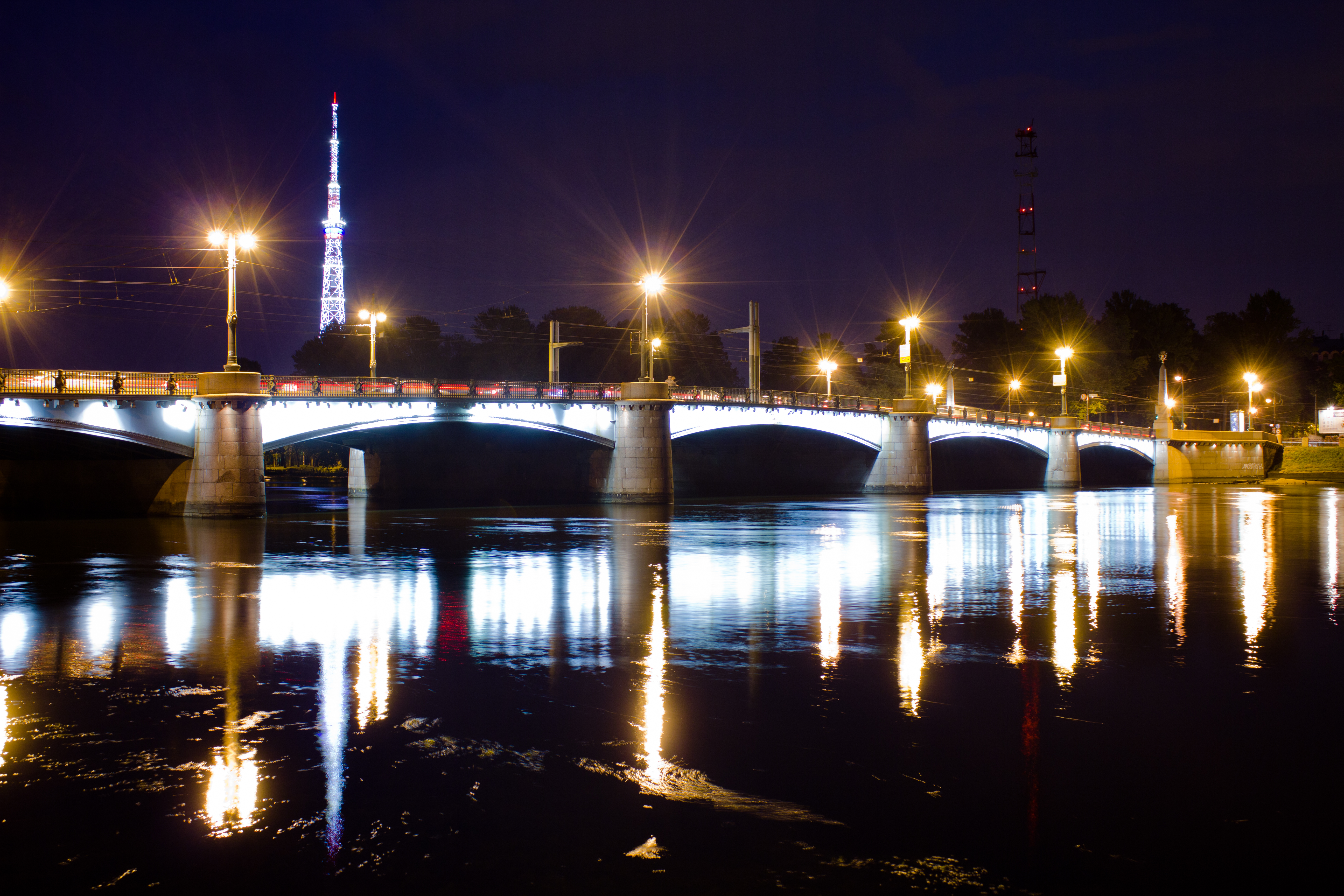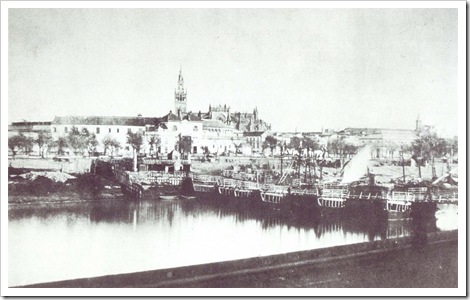|
Kamennoostrovsky Bridge
Kamennoostrovsky Bridge spans the Little Nevka River and connects Aptekarsky Island with Kamenny Island in Saint Petersburg, Russia. Originally constructed as a floating pontoon bridge in 1760. Between 1811 and 1813, Kamennoostrovsky Bridge became the first seven span timber arch bridge in Russia. In 1859, the bridge was improved with the addition of strut-supported spans. In 1952, the bridge was rebuilt to its current design with five spans. Original construction The bridge was originally designed by architect in 1760 to be a pontoon bridge consisting of 11 pontoon sections. In 1765, the pontoons were replaced with a floating bridge and was connected to the river abutments on piles. 19th century improvements Between 1811 and 1813, Project Engineer Agustín de Betancourt replaced the floating bridge with a seven span wooden arch bridge on timber foundations with stone abutments. The total length of the bridge in this form was . In 1859, Project Engineer conducted a ... [...More Info...] [...Related Items...] OR: [Wikipedia] [Google] [Baidu] |
Little Nevka River
The Little Nevka or Malaya Nevka (russian: Ма́лая Не́вка) is the southern distributary of the Great Nevka. The Great Nevka splits into Little Nevka (the southern armlet) and Middle Nevka (the northern armlet) near the Kamenny Island's easternmost tip. It is also known for being the dumping ground of the famous Rasputin (of Russia) after his assassination. The Little Nevka is about long; the width is from , and the depth is . It has its own armlets: Krestovka, Karpovka and Zhdanovka. There are four bridges across Little Nevka: Kamennoostrovsky Bridge, Lazarevsky Bridge, Big Krestovsky Bridge, Bolshoy Petrovsky Bridge The Great or Bolshoi Petrovsky bridge is a bridge across Little Nevka in St. Petersburg, Russia, connecting Petrovsky Island with Krestovsky Island and passing over a small nameless islet on Little Nevka. It is very near the mouth of the rive .... Rivers of Saint Petersburg Distributaries of the Neva {{Russia-river-stub ... [...More Info...] [...Related Items...] OR: [Wikipedia] [Google] [Baidu] |
Saint Petersburg
Saint Petersburg ( rus, links=no, Санкт-Петербург, a=Ru-Sankt Peterburg Leningrad Petrograd Piter.ogg, r=Sankt-Peterburg, p=ˈsankt pʲɪtʲɪrˈburk), formerly known as Petrograd (1914–1924) and later Leningrad (1924–1991), is the List of cities and towns in Russia by population, second-largest city in Russia. It is situated on the Neva River, at the head of the Gulf of Finland on the Baltic Sea, with a population of roughly 5.4 million residents. Saint Petersburg is the List of European cities by population within city limits, fourth-most populous city in Europe after Istanbul, Moscow and London, the List of cities and towns around the Baltic Sea, most populous city on the Baltic Sea, and the world's List of northernmost items#Cities and settlements, northernmost city of more than 1 million residents. As Russia's Imperial capital, and a Ports of the Baltic Sea, historically strategic port, it is governed as a Federal cities of Russia, federal city. ... [...More Info...] [...Related Items...] OR: [Wikipedia] [Google] [Baidu] |
Aptekarsky Island
Aptekarsky Island (russian: Апте́карский о́стров, , "Apothecary Island", fi, Korpisaari, "Deep Forest Island") is a relatively small island situated in the northern part of the Neva delta. It is separated from Petrogradsky Island by the Karpovka River, from Kamenny Island and Krestovsky Island by the Malaya Nevka and from the Vyborgskaya region of St-Petersburg by the Bolshaya Nevka. It has an area of approximately two square kilometres. Aptekarsky Island is connected to Petrogradsky Island by seven bridges: Aptekarsky Bridge, Petropavlovsky Bridge, Silyn Bridge, Geslerovsky Bridge, Karpovsky Bridge, Barochny Bridge and Molodyozhny Bridge. It is connected to Kamenny Island by Kamennoostrovsky Bridge and to the Vyborgskaya region by Kantemirovsky Bridge and Grenadersky Bridge. In 1714, Tsar Peter I gave orders to transform the island into a headquarters for the Medical Clerical Office and the Main Pharmacy. The island's name, Aptekarsky, means ... [...More Info...] [...Related Items...] OR: [Wikipedia] [Google] [Baidu] |
Kamenny Islands
Kamenny Islands (russian: Каменные острова, ''Kamenny Ostrova'', meaning 'Stony Islands') are a group of three islands in the Neva delta, in Saint Petersburg, Russia. Geography The three islands are flat. They are divided by channels and have bridges connecting each other, as well as the group with the mainland. The Kamenny Islands are part of the city of Saint Petersburg. Kamenny Island Kamenny Island (russian: Каменный остров, meaning 'Stone Island'), with an area of 1.06 km², it is the easternmost island and gives its name to the group. It was renamed as Workers' Island (russian: остров Трудящихся) in Soviet times.Городские имена сегодня и вчера: Ленинградская топонимика/Сост С. Алексеева, А. Владимирович, А. Ерофеев и др. — Л.:Добровольное общество любителей книги РСФСР, Ленингр. орг-ция/Р� ... [...More Info...] [...Related Items...] OR: [Wikipedia] [Google] [Baidu] |
Russia
Russia (, , ), or the Russian Federation, is a transcontinental country spanning Eastern Europe and Northern Asia. It is the largest country in the world, with its internationally recognised territory covering , and encompassing one-eighth of Earth's inhabitable landmass. Russia extends across eleven time zones and shares land boundaries with fourteen countries, more than any other country but China. It is the world's ninth-most populous country and Europe's most populous country, with a population of 146 million people. The country's capital and largest city is Moscow, the largest city entirely within Europe. Saint Petersburg is Russia's cultural centre and second-largest city. Other major urban areas include Novosibirsk, Yekaterinburg, Nizhny Novgorod, and Kazan. The East Slavs emerged as a recognisable group in Europe between the 3rd and 8th centuries CE. Kievan Rus' arose as a state in the 9th century, and in 988, it adopted Orthodox Christianity from the ... [...More Info...] [...Related Items...] OR: [Wikipedia] [Google] [Baidu] |
Pontoon Bridge
A pontoon bridge (or ponton bridge), also known as a floating bridge, uses floats or shallow- draft boats to support a continuous deck for pedestrian and vehicle travel. The buoyancy of the supports limits the maximum load that they can carry. Most pontoon bridges are temporary and used in wartime and civil emergencies. There are permanent pontoon bridges in civilian use that can carry highway traffic. Permanent floating bridges are useful for sheltered water crossings if it is not considered economically feasible to suspend a bridge from anchored piers. Such bridges can require a section that is elevated or can be raised or removed to allow waterborne traffic to pass. Pontoon bridges have been in use since ancient times and have been used to great advantage in many battles throughout history, such as the Battle of Garigliano, the Battle of Oudenarde, the crossing of the Rhine during World War II, the Iran–Iraq War's Operation Dawn 8, and most recently, in the 2022 Ru ... [...More Info...] [...Related Items...] OR: [Wikipedia] [Google] [Baidu] |
Agustín De Betancourt
Agustín de Betancourt y Molina ( rus, Августин Августинович де Бетанкур, r=Avgustin Avgustinovich de Betankur; french: Augustin Bétancourt; 1 February 1758 – 24 July 1824) was a prominent Spanish engineer, who worked in Spain, France and Russia. His work ranged from steam engines and balloons to structural engineering and urban planning. As an educator, Betancourt founded and managed the Spanish Corps of Civil Engineers and the Saint Petersburg Institute of Communications Engineers. As an urban planner and construction manager, Betancourt supervised planning and construction in Saint Petersburg, Kronstadt, Nizhny Novgorod and other Russian cities. Childhood and education De Betancourt was born in Puerto de la Cruz, Tenerife, Spain. The Tenerife Betancourt family can trace their roots to Jean de Béthencourt, who launched colonization of the Canary Islands in 1402 and became a self-proclaimed King of Tenerife in 1417 under the overlordship of the ... [...More Info...] [...Related Items...] OR: [Wikipedia] [Google] [Baidu] |
I-beam
An I-beam, also known as H-beam (for universal column, UC), w-beam (for "wide flange"), universal beam (UB), rolled steel joist (RSJ), or double-T (especially in Polish, Bulgarian, Spanish, Italian and German), is a beam with an or -shaped cross-section. The horizontal elements of the are flanges, and the vertical element is the "web". I-beams are usually made of structural steel and are used in construction and civil engineering. The web resists shear forces, while the flanges resist most of the bending moment experienced by the beam. The Euler–Bernoulli beam equation shows that the I-shaped section is a very efficient form for carrying both bending and shear loads in the plane of the web. On the other hand, the cross-section has a reduced capacity in the transverse direction, and is also inefficient in carrying torsion, for which hollow structural sections are often preferred. History The method of producing an I-beam, as rolled from a single piece of wrought iron, wa ... [...More Info...] [...Related Items...] OR: [Wikipedia] [Google] [Baidu] |
Bascule Bridge
A bascule bridge (also referred to as a drawbridge or a lifting bridge) is a moveable bridge with a counterweight that continuously balances a span, or leaf, throughout its upward swing to provide clearance for boat traffic. It may be single- or double-leafed. The name comes from the French term for balance scale, which employs the same principle. Bascule bridges are the most common type of movable span because they open quickly and require relatively little energy to operate, while providing the possibility for unlimited vertical clearance for marine traffic. History Bascule bridges have been in use since ancient times, but until the adoption of steam power in the 1850s, very long, heavy spans could not be moved quickly enough for practical application. Types There are three types of bascule bridge and the counterweights to the span may be located above or below the bridge deck. The fixed- trunnion (sometimes a "Chicago" bascule) rotates around a large axle that raises the ... [...More Info...] [...Related Items...] OR: [Wikipedia] [Google] [Baidu] |
List Of Bridges In Saint Petersburg
There are more than 342 bridges in the city limits of Saint Petersburg, Russia. This is a partial list of the most famous ones. Peter the Great was designing the city as another Amsterdam and Venice, with canals instead of streets and citizens skillful in sailing. Initially, there were only about ten bridges constructed in the city, mainly across ditches and minor creeks. By Peter's plans, in the summer months, the citizens were supposed to move around in boats, and in the winter months when the water froze to move in sledges. However, after Peter's death, new bridges were built, as it was a much easier way of transportation. Temporary ponton bridges were used in the summertime. The first permanent bridge of bricks and stones across the main branch of the Neva river appeared in 1850. Today, there are more 342 bridges over canals and rivers of various sizes, styles and constructions, built at different periods. Some of them are small pedestrian bridges, such as Bank and Lion bridge ... [...More Info...] [...Related Items...] OR: [Wikipedia] [Google] [Baidu] |



